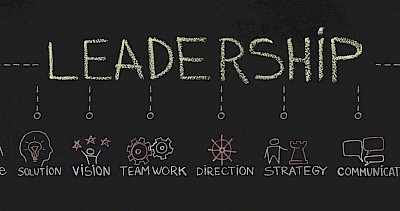
Lateral leadership
Lateral leadership
With the entry of younger generations into the professional world, the trend towards more self-fulfilment as well as the tendency towards more cross-divisional project work, more and more companies are turning to flatter hierarchies and anti-authoritarian leadership styles. Instead of supervisors with disciplinary power, team members with lateral leadership functions are used to coordinate tasks between different areas and steer them in the direction of the common goal. But what exactly is lateral leadership? When is this type of leadership used and how can it work? In this blog article you will get all the relevant info on the topic of leading without authority and will be informed about the advantages and disadvantages.
Leading without authority: What is lateral leadership?
The term "lateral leadership" is derived from the Latin word "latus" and means "side". Lateral leadership therefore refers to leadership by managers who are not above other employees in the hierarchy, but lead from the same level on an equal footing without direct authority. In contrast to the traditional, hierarchical style of leadership, lateral leadership is not about exerting power and control, but about leading with conviction and inspiration and evoking autonomous working. Employees in lateral leadership positions are to be understood more as mentors who show the way to their team colleagues at eye level. Also, mistakes are not disciplined but welcomed for the learning process.
The concept of lateral leadership originated in the 1960s and has become much more significant in modern companies, especially in recent years. Increasing complexity and dynamics require new approaches and skills. Teams and projects are increasingly interdisciplinary and heterogeneous. Hierarchical organisational structures and traditional leadership methods reach their limits here. Lateral leadership enables better collaboration and cooperation between individual team colleagues and promotes a culture of trust and openness - the prerequisite for innovation and creativity.
Where does lateral leadership apply?
Lateral leadership takes place at different company levels. Regardless of the sector, a responsible employee with a lateral leadership function is advantageous when tasks or project work involve the collaboration of different departments. In this case, different interests and expertise come together in a working group, which the project leader has to plan, coordinate and monitor. Usually this person is in a staff function and is assigned by the management with a specific concern. The involvement of external stakeholders, such as external service providers or partners, also requires a person in a company who can ensure that understanding is free of complications and who can bring about compromises in conflict situations with negotiating skills. In larger companies, where certain planning and decisions are handed over to boards and committees, lateral leadership also takes place.
Success factors for lateral leadership in your company
Non-supervisory managers are responsible for planning tasks and projects, coordinating them and ultimately completing them successfully. Since the leadership tasks of a project manager fundamentally include dealing with and dealing with different people and points of view, lateral leadership can only work if the manager has basic expertise in all areas involved as well as in-depth leadership skills. The following coordination mechanisms therefore take on a particularly central role in the leadership position without authority to issue directives:
Effective communication at eye level
As an interface between different interest groups, it is indispensable for a project leader to be skilled in communication. The intention of a leader without authority to issue directives is to work as a team to achieve an overarching goal. In order to avoid misunderstandings and to quickly identify and resolve potential conflicts, a certain level of communication skills is required. With empathy and knowledge of human nature, it is possible to respond to each person and resolve conflicts in a constructive way.
Charisma as a source of power instead of authority
In lateral leadership there is no superior function. The goal of lateral leadership is not to use authority to persuade employees and colleagues to carry out a certain task, but to motivate them to carry out the task independently and to convince them of ideas with charisma, personal expertise and humanity.
Creating a basis of trust
The basis for a relaxed, collegial and productive working relationship is mutual trust between all participants. Formulating common values helps to lay a foundation for successful cooperation.
Ensure good understanding
In addition to trust and knowledge of human nature, all persons involved must feel that they can openly state their concerns and views. Understanding is therefore the be-all and end-all. By creating an open feedback culture, the needs and perspectives of all employees are taken into account.
Advantages of lateral leadership
- Innovation & efficiency: Through collaboration and the exchange of ideas and perspectives, new and creative approaches to solutions can be found. The use of resources is also optimised, as team colleagues can contribute their skills and experience more effectively. In this way, projects can be implemented faster and more efficiently in teamwork.
- Motivation & satisfaction: A feeling of togetherness and motivation is created through an open feedback culture and the consideration of employees' needs and perspectives. This leads to higher satisfaction and employee loyalty to the company and reduces fluctuation.
- Talent development: Through cooperation and the assumption of responsibility, the potential and competencies of each individual are promoted. This allows new leaders to emerge and a broader base of leadership skills to be built.
- Decision-making freedom & development: In the spirit of self-fulfilment, employees today want to be involved in decision-making processes that directly or indirectly affect them. With a lateral leadership style, employees can decide autonomously to a certain extent and thus prove themselves and their skills.
- Error culture: Mistakes are not taboo in lateral structures. On the contrary, everyone makes mistakes and learns from them. Lateral leadership sees mistakes as a learning factor and personal development.
- Team cohesion: The concept of lateral leadership is based on teamwork. Each member is indispensable and plays an important role. This strengthens the team spirit and creates a pleasant and productive working atmosphere.
Lateral leadership: the challenges
Leaders who do not have disciplinary authority are often confronted with certain challenges. Even though lateral leadership is becoming more and more common nowadays, lateral leaders do not always meet with acceptance from all team members. It is not uncommon for workers to still see the authority and power of superiors as superior to the competencies of lateral leaders and to reject ideas and suggestions. Especially in situations where a decision has to be made, a lack of acceptance can slow down or even block processes. Instructions expressed by lateral leaders can be disregarded by colleagues. Therefore, creating mutual trust, a common framework of thinking as well as respectful interaction with each other is of great importance.
Conflicts and tensions between employees are another difficulty. Although lateral leaders do have a leadership role, they usually do not have an authoritarian role to resolve conflicts.
Conclusion: Lateral leadership without a superior function
Due to the increasing interconnectedness in the modern working world, lateral leadership is a promising approach to effectively achieve corporate goals while at the same time involving employees in decision-making processes in an appreciative manner. Since this type of leadership does not provide for authority to issue directives and is usually exercised in companies with a flat hierarchy, integrity, flexibility and charisma mainly serve as a source of power. Only in this way can employees who coordinate projects across teams be sure that colleagues reliably complete their tasks. As a senior employee without a superior function, it is also of great importance to act successfully in a field of tension. Because not everyone involved always agrees. The competence to find compromises and to negotiate is therefore indispensable.
In order to understand the way others work and to support them, lateral leadership also requires a certain technical know-how of the individual areas. Although leading without authority promotes various benefits such as innovation, efficiency and staff retention, responsible employees are confronted with some challenges. Occasionally, influencing certain colleagues fails because they do not accept the leadership position or difficult conflict situations between team colleagues cannot be ended with a word of power. You are supposed to lead laterally and need the appropriate tools to do so? In our seminar Leading without a supervisor function, we prepare you for all challenges in the best possible way.








